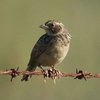Genus Mirafra

Mirafra affinis - M. affinis has arrowhead like spots pointing upwards on the breast. It is very similar to the Indian Bushlark but has buffy lores, less white behind ear coverts, darker centre to wing coverts and central tail feathers. Dark centres of primary coverts are prominent, and wing panels are duller and rufous. In southern Western Ghats race ceylonensis is darker and more rufous on the underside and a longer bill.
Rufous-naped Lark - The Rufous-naped lark's range is very large, with an estimated global Extent of Occurrence of 5,600,000 square km. It is found in the following countries:
Fawn-coloured Lark - The range of Mirafra africanoides is broadly spread, with an estimated global Extent of Occurrence of 2,400,000 square km. Countries it can be found in are Angola, Botswana, Ethiopia, Kenya, Mozambique, Namibia, Somalia, South Africa, Tanzania, Uganda, Zambia, and Zimbabwe.
White-tailed Bush Lark - The range of M. albicauda is quite large, with an estimated global Extent of Occurrence of 430,000 square km., endemic in Chad, Democratic Republic of Congo, Ethiopia, Kenya, Sudan, Tanzania, and Uganda.
Abyssinian Lark - M. alopex has a large range, with an estimated global Extent of Occurrence of 100,000-1,000,000 square km.
Angola Lark - The range of Mirafra angolensis is sizable, within Angola, The Democratic Republic of the Congo, United Republic of Tanzania, Zambia. It is estimated to have a global Extent of Occurrence of about 170,000 square km.
Clapper Lark - It has at least three distinctive subspecies which are considered by some authorities to be full species.
Ash's Lark - In the case of some lark species, as with Ash's Lark it is hard to describe definitively without having to compare its characters with those of some of its close relatives. It is insufficient to say only that it is a small lark that has greyish-brown upperparts with paler edging to its mantle feathers; and having buff-colored underbelly|underparts with brownish streaks, but a paler belly and vent; and with a light crest, and buff eyebrow-stripes.
Rufous-winged Bushlark - It is short-tailed and has a strong stout bill. In size it is not as long as the Skylark, measuring about 15 centimeters.
Western Singing Bush Lark - The range of M. cantillans is quite extensive, with an estimated global Extent of Occurrence of 10,000,000 km2.; and its global population is thought to be large, though it has yet to be quantified.
Melodious Lark - The species as a whole has, perhaps, a maximum range of 110,400 km2., but this is something of a tattered web; small, isolated communities are strewn primarily about parts of South Africa , with fewer still in Botswana and Zimbabwe, and have limited opportunites for social interaction with each other.
Collared Lark - Mirafra collaris has a considerable range, with an estimated global Extent of Occurrence of 530,000 square km. over Ethiopia, Kenya, and Somalia.
Kordofan Bush-lark - The Kordofan Lark has a range that is quite large spanning seven African nations; Burkina Faso, Chad, Mali, Mauritania, Niger, Senegal, and Sudan. Its global Extent of Occurrence is estimated at 1,900,000 km2.
Mirafra erythrocephala - The Indochinese Bushlark is a species of lark in the Alaudidae family.
Indian Bushlark - Pale and found mostly in arid areas. Has cheek patch completely bounded by white supercilium and post-auricular border. Crown and upperparts heavily streaked. Pale underparts have large spots on the breast. Differentiable from Jerdon's Bushlark by longer tail, shorter bill and legs. Most wing coverts, tertials and central tail feathers have pale centres. Primary coverts look all brown. Sings from bush tops but does not usually perch on trees or wires. Calls similar to that of Jerdon's but is lower and has longer rattling tremolos. Often falling in pitch.
Gillett's Lark - Mirafra gilletti has a somewhat wide range, with an estimated global Extent of Occurrence of 690,000 square km. over Ethiopia, Kenya, and Somalia.
Hova Lark - The range of the Madagascar Lark is large, with an estimated global Extent of Occurrence between 100,000 and 1,000,000 km2.
Red-winged Lark - The range of Red-winged Lark is quite extensive within Ethiopia, Kenya, Somalia, Sudan, Tanzania, and Uganda, with an estimated global Extent of Occurrence of 660,000 km2.
Singing Bushlark - M. javanica is brown with grey streaks and mottling.
Mirafra microptera - Although the global population of Mirafra microptera has not yet been quantified, it is believed to be locally numerous within its sizable range in central myanmar, where it is endemic, and is estimated to have a global Extent of Occurrence of anywhere from 50,000 to 100,000 square km.
Monotonous Lark - The range of M. Passerina is quite broad, extending over six countries in Africa; Angola, Botswana, Namibia, South Africa, Zambia, and Zimbabwe. It's global Extent of Occurrence is estimated at 1,400,000 km2.
Pink-breasted Lark - M. poecilosterna is estimated to have a global Extent of Occurrence of 560,000 km2. covering a broad range over Ethiopia, Kenya, Somalia, Sudan, Tanzania, and Uganda.
Friedmann's Lark - Friedmann's Lark is found in Ethiopia, Kenya, and Tanzania, but its population and real range is very poorly known.
Rusty Bush Lark - The range of M. rufa is large, with an estimated global Extent of Occurrence of 470,000 km2. It is typically found inhabiting the dry savanna ecoregions of Chad, Mali, Niger, Sudan, and Togo.
Flappet Lark - Mirafra rufocinnamomea has a large range covering much of the African continent with an estimated global Extent of Occurrence of 10,000,000 square km. They are endemic to the following countries:
Sabota Lark - The Sabota Lark is a species of lark in the Alaudidae family.
Somali Lark - The range of M. somalica is somewhat large, with an estimated global Extent of Occurrence of 270,000 km2.
Williams' Lark - In general, the natural habitat of M. williamsi is subtropical or tropical dry shrubland. Its range is restricted to northern Kenya where it is found in two disjunct populations:



